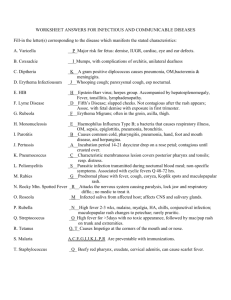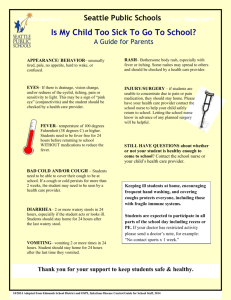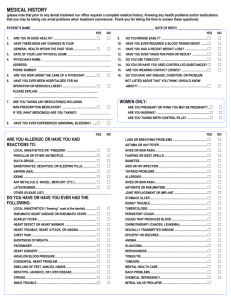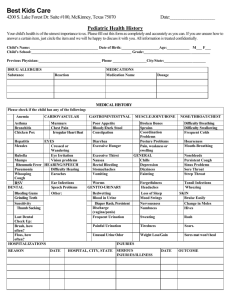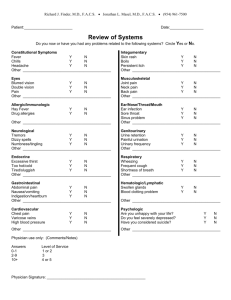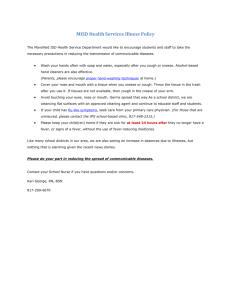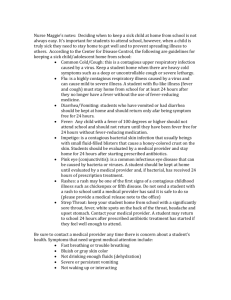Paediatrics - Sheffield Peer Teaching Society
advertisement
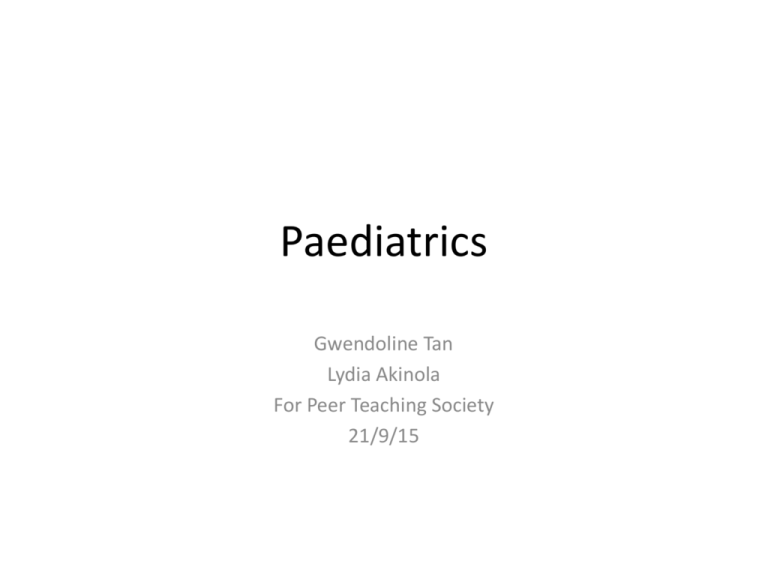
Paediatrics Gwendoline Tan Lydia Akinola For Peer Teaching Society 21/9/15 What we will cover • Viral/bacterial rashes in children • Difficulty breathing Measles • Prodrome: cough, coryza, conjunctivitis, Koplik spots, fever • Maculopapular rash starts behind ears • Complications – – – – – encephalitis giant cell pneumonia subacute sclerosing panencephalitis febrile convulsions keratoconjunctivitis, corneal ulceration • MMR within 72h of measles contact for nonimmunised child Mumps • Fever, malaise, parotitis • Becomes bilateral in 70% • Complications – Pancreatitis – Orchitis – Meningitis/encephalitis Rubella • Pink macular rash which starts on face and spreads to trunk • Suboccipital and postauricular lymphadenopathy • In utero – 1st to 4th week: eye anomaly – 4th to 8th week: cardiac abnormality – 8th to 12th week: deafness Erythema infectiosum (fifth disease) • Parvovirus B19 • Lethargy, fever, headache, ‘slapped-cheek' rash on face and limbs • Can cause marrow to stop producing RBCs aplastic crisis transfusions Roseola infantum (sixth disease) • • • • HHV6 High fever and MP rash when fever subsides Febrile convulsions (10-15%) Can cause aseptic meningitis, hepatitis Hand foot mouth disease • Coxsackie A16/enterovirus 71 • Sore throat, fever, oral ulcers then vesicles on palms and soles Chickenpox • • • • • Varicella zoster virus (HHV3) Can be caught from someone with shingles Fever, rash often starting on back Macule papule vesicle ulcer crust Complications: purpura fulminans, necrotising fasciitis, pneumonia, meningitis • VZV Ig + aciclovir if immunosuppressed Herpes simplex • Gingivostomatitis: vesicles on lips, gums, tongue, palate high fever, painful eating and drinking • Cold sores – usually HSV1 • Complications – – – – – Eczema herpeticum Herpetic whitlows Blepharitis/conjunctivitis Aseptic meningitis HSV encephalitis Molluscum contagiosum • • • • Umbilicated papules caused by Pox virus Spread by direct contact More extensive in those with eczema/HIV Usually resolves w/o treatment in 18mths Scarlet fever • Group A strep (S. pyogenes) – seen poststrep/impetigo • Fever, sore throat, strawberry tongue, rash • Rash 12-48h after fever, feels like sandpaper/goosebumps • Peeling skin in armpits/groin/fingers and toes • Complications: OM, post-strep GN, rheumatic fever, septicaemia, pneumonia • Penicillin V PO Impetigo • Contageous staph/strep skin infection • Erythematous vesicular golden honeycoloured crusted lesions • Topical mupirocin or fusidic acid if mild • Flucloxacillin or erythromycin if extensive Meningococcal septicaemia • Non-blanching purpuric rash, fever, unwell child, shock • IM benzylpenicillin in community, IV ceftriaxone Age Organism Neonate – 3m GBS, E. coli, Listeria monocytogenes 1m – 6y N. meningitidis, S. pneumoniae, H. influenzae >6y N. meningitidis, S. pneumoniae Nappy rash • Ammoniac – Crease-sparing – Erythematous – Irritant dermatitis – barrier cream e.g. Sudocrem • Candida – Creases involved – Satellite lesions – Treat with antifungal Other rashes to revise • • • • • • • Eczema Dermatitis herpetiformis Cellulitis/erysipelas Henoch-Schonlein purpura Tinea Scabies Don’t forget to consider NAI Breathing difficulties Airway Assessment • Secretions or stridor • Foreign body • Unprotected airway Breathing assessment • • • • Respiratory rate Recession and use of accessory muscles Oxygen saturations Auscultation Age < 1 year 1-2 years 2-5 years 5-12 years > 12 years Resp. Rate 30-40 25-35 25-35 20-25 15-20 Wheeze Common Rare Infection – bronchiolitis, viral induced wheeze, whooping cough, pneumonia Cystic fibrosis Asthma (> 1 year of age) Cow’s milk protein intolerance Foreign body inhalation External compression of airway Gastro-oesophageal reflux Heart failure Recurrent aspiration Persistent cough Common Uncommon Post-infection Pertussis Recurrent URTIs Foreign body Post-nasal drip Gastro-oesophageal reflux Asthma (exercise, night) Cystic fibrosis Cigarette smoke Tuberculosis Habit Immune deficiency Respiratory distress Symptom Signs Breathlessness Tachypnoea Difficulty talking Tachycardia Difficulty feeding Dyspnoea Wheeziness Recession Sweatiness Cyanosis Nasal flaring Use of accessory muscles Expiratory grunting Crackles Downward displacement of the lung Case A 14 month old girl is seen with a 2 day history of a loud cough. She has a fever of 38.5°C, a respiratory rate of 35, stridor and marked intercostal and subcostal recession. She is playful and is feeding well. (taken from Paediatrics: Clinical Case Uncovered) Asthma Asthma Features of episode that suggest asthma include: • Nocturnal symptoms • Recurrent cough, shortness of breathe, wheeze • Worse following exposure to trigger • Personal/family history of atopy • Widespread wheeze on auscultation • Improvement with treatment Asthma • What are the symptoms of life-threatening asthma? • What might you find on examination? • What might you find on spirometry? Asthma What are the side effects of chronic treatment? Cystic fibrosis Cystic fibrosis • Which other organs can be affected? • Name 3 ways that CF may present? • Name 5 people involved in CF MDT Case A 3 year old boy is in acute respiratory distress. There is no past history of note except he has not been immunised. He has a temperature of 40C, looks flushed and unwell, is drooling and has an inspiratory stridor. His cough is muffled. A colleague asks for help examining the boy’s throat. Which is the single most appropriate advice to give? (taken from Oxford Assess & Progress) A – do not disturb the child, and call for senior help urgently B – give neb budesonide and then examine the throat C – go ahead and examine the throat, but have a laryngoscope and endotracheal tube to hand D – go ahead and examine the throat straight away to help make diagnosis E – site an IV line and give a dose of cefotaxime first, then examine the throat Airway inflammation Croup Epiglottis Time course Days Hours Prodrome Coryza None Cough barking Slight if any Feeding Can drink No Mouth Closed Drooling saliva Toxic No Yes Fever < 38.5°C > 38.5°C Stridor Rasping Soft Voice Hoarse Weak or silent Croup • Also known as acute laryngotracheobronchitis • https://www.youtube.com/watch?v=XpPVYm ALPoA • Most commonly caused by parainfluenza virus • What are the treatment options? Pneumonia Age Pathogens Neonates Group B streptococcus Escherichia coli (and other enterococci) Chlamydia trachomatis Infants Respiratory virus (e.g. RSV, adenovirus) Streptococcus pneumoniae Haemophilus influenzae Bordetella pertussis Staphylococcus aureus (RARE) Children Streptococcus pneumoniae Haemophilus influenzae Group A streptococcus Adolscents As above Mycoplasma pneumoniae Chlamydia pnuemoniae Whopping cough • http://www.parents.com/videos/v/97819228/ what-does-whooping-cough-sound-like.htm Case A 6 week old is seen in the ‘failure to thrive’ clinic. For 3 weeks her feeding has been poor with only 30-60 ml of milk taken each feed, in several short bursts. There is no cough. Her respiratory rate is 60/min she has mild recession and inspiratory crackles. (taken from Paediatrics: Clinical Case Uncovered) Other conditions to revise • Bronchiolitis • URTIs include acute otitis media • Chronic lung disease of prematurity
